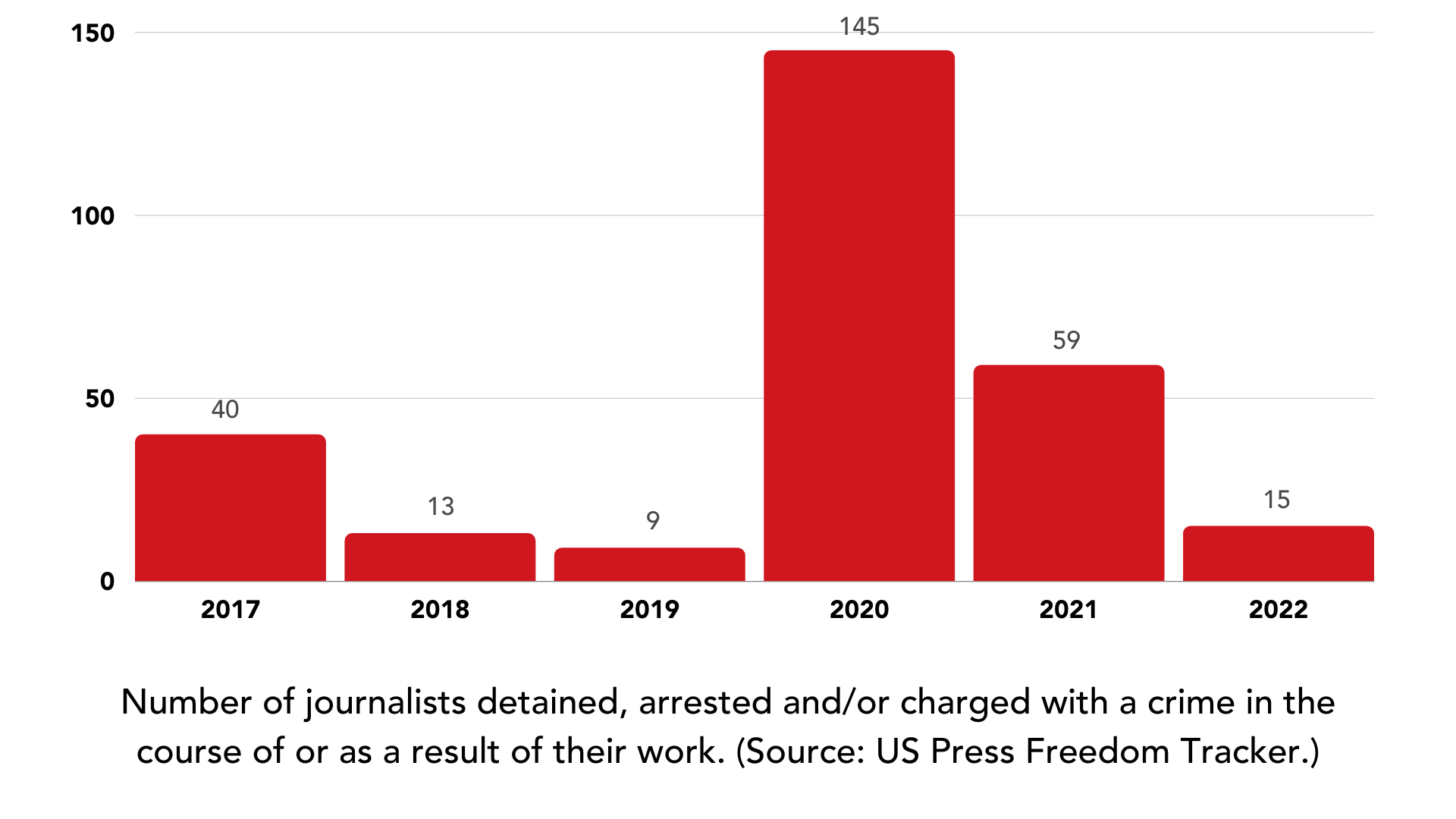Arrests of journalists continued their decline in 2022, but 2020 still casts a shadow

This is the third installment of our newsletter series analyzing U.S. press freedom violations in 2022. You can find links to all four parts in this blog post.
Last year, the number of reporters arrested in the course of newsgathering continued its sharp decline from a historic peak in 2020. (The U.S. Press Freedom Tracker pegs the tally at 15 — too many, but a world away from the nearly 150 detentions recorded during the nationwide protests against racial injustice and police brutality.) That headline figure is worth applauding; whether it represents lasting progress for journalists’ rights is a more complicated question. In important respects, the story of 2020’s impact on press freedom was still being written last year, as pending prosecutions, unresolved litigation, and ongoing reform efforts continued to work their way through the legal system.
As the Tracker’s Stephanie Sugars observed at the end of last year, arrest figures fell off a cliff “due in large part to fewer national protests.” But whenever demonstrations next explode on the scale they did in 2020, will reporters on the scene be any safer than they were the last go-round? On paper and on the ground, developments in 2022 offered up mixed data at best.
Already, some of the reforms implemented in response to police violence against journalists seem to need shoring up. California, for instance, adopted a new law in 2021 — backed by the Reporters Committee for Freedom of the Press — that restricts law enforcement’s latitude to arrest or disperse reporters covering demonstrations. But as Voice of America has reported, journalists’ experiences interacting with the Los Angeles Police Department last year raise serious questions as to whether agencies are faithfully implementing that law. (According to the Tracker’s data, one-third of last year’s arrests took place during a single night of protests in Los Angeles.)
Other safeguards have faded with changed circumstances. Few press-freedom cases in 2020 drew more attention than the suit challenging the violent dispersal of journalists on the streets of Portland, Oregon; that litigation established important precedent on press rights, but the preliminary injunctions that Index Newspapers won against the U.S. Marshals Service and the city of Portland have since been dissolved, now that protests on the city’s streets are only “sporadic.” And while those plaintiffs continue to pursue claims for damages against the individual officers responsible, the U.S. Supreme Court’s 2022 decision in Egbert v. Boule all but closed the door to suits that seek to hold federal officials personally liable for violating First Amendment rights.
Still, there were promising developments, too. Last September, trespass charges against April Ehrlich related to her coverage of the clearing of an encampment in Medford, Oregon — pending since 2020 — were finally dismissed. (The Reporters Committee, joined by a coalition of 52 news organizations, had filed a friend-of-the-court letter urging that result.) Like a number of other journalists whose rights were violated that year, Ehrlich has since sued the city, seeking further accountability for her arrest.
Other long-running bids for reform have also begun to bear fruit. In 2021, for instance, the Justice Department announced that it would be probing unconstitutional policing practices in Minneapolis, Minnesota; Louisville, Kentucky; and several other jurisdictions. A media coalition led by the Reporters Committee urged the Department’s investigators to address the treatment of the press by law enforcement agencies in those cities, and in March the Louisville investigative team announced a finding that the Louisville Metro Police Department “subjected both credentialed press and livestreamers to mass arrests and retaliatory force” during the 2020 protests. What remedy the Department will aim to impose remains to be seen; the Minneapolis probe, for its part, remains pending. Still, the Louisville report is a promising sign of federal attention to those concerns.
There is, of course, no permanent and uniform solution to the problem of police retaliation against journalists — the drive for accountability will move forward case by case, jurisdiction by jurisdiction. Important progress has been made in responding to the staggering press-freedom violations seen in 2020. But as the Tracker’s 2022 findings and the stories behind them highlight, three years later, the work of redressing those harms is very much ongoing.
As a member of the U.S. Press Freedom Tracker’s advisory board, the Reporters Committee for Freedom of the Press has published annual reports analyzing press freedom violations confirmed by Tracker researchers each year and highlighting the Reporters Committee’s work to protect journalists and the public’s right to access information. You can find reports from 2017, 2018, 2019, 2020, and 2021 on our website.